How I Take Care of My 100-Year-Old Cast Iron Cookware

![]()
When my grandmother got married in 1922, she was given a set of sturdy cast iron cookware and other practical items a farmer’s wife needed in those days.
Her cast iron pan fed her kids including my father, and her grandkids. When she passed away in 1981, my father inherited her cast iron pan and continued to use it for a few years.
Eventually, it ended up in the back of a cupboard where it ever-so-slowly started to rust.
A few years before his passing, he downsized and passed down Grandma’s cast iron pan to me, asking if I wanted it.
Realizing the cast iron pan had a deep legacy attached to it, and a lot of culinary potential, I took the time to bring it back to life.
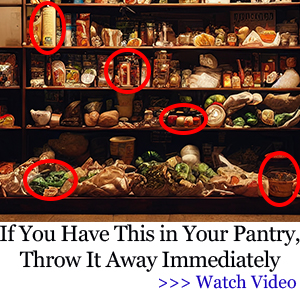 Now 100 years on, I use it to grill, bake deep-dish pizza, and bring it on backwoods camping trips with my daughter.
Now 100 years on, I use it to grill, bake deep-dish pizza, and bring it on backwoods camping trips with my daughter.
There’s a certain technique to bringing a 100-year-old cast iron cookware back to life and properly maintaining it.
If you recently found an old one that’s worth saving, or you just bought a piece of cast iron cookware, and you want to treat it right from day one, these are the things you need to know.
The first step in restoring a piece of cast iron cookware is to remove every spec of rust. This is a reality simple process of scrubbing and using everyday items to clear away the patina of rust.
Just don’t rush it. You need to be meticulous or your later attempts at maintaining the cast iron’s seasoning layer will be challenging.
Create a paste that is 2 parts baking soda to 1 part water. You want it on the thicker side. You can always add a little more water later if you need it.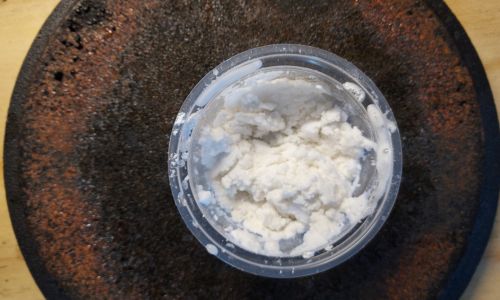
Then apply some baking soda paste to the cast iron and scrub vigorously with a scouring pad.
This isn’t the time for steel wool. You want a scouring pad or even an old washcloth that lets you do some fine grinding on every square inch of the rusted cast iron surface.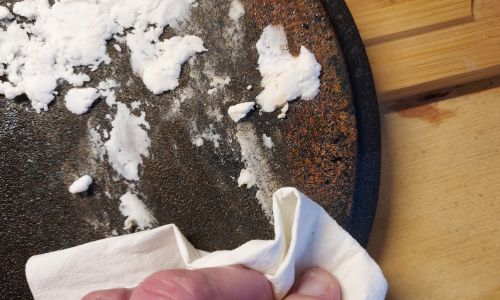
Pouring vinegar on the cast iron surface will help neutralize some of the baking soda. It also helps strip away any lingering seasoning layers or other polymerized carbon to get you down to the bare metal.
Related: Making Raw Apple Cider Vinegar at Home
Then wipe the pan down with clean paper towels to take away the rust along with whatever’s left of the baking soda and vinegar.
Set your oven to 400+ degrees, and while it’s preheating give your cast iron a thorough washing in the sink. You can use steel wool to scrape off any stuck-on residue if needed. The goal is to clean away any particulate matter from the surface of the cast iron before seasoning it again.
If you’re restoring rusty cast iron cookware or you just want to properly maintain your new cast iron for the next 100 years, you need to start with a clean surface. If you’ve already stripped the rust off the old cast-iron, you’re ready to go.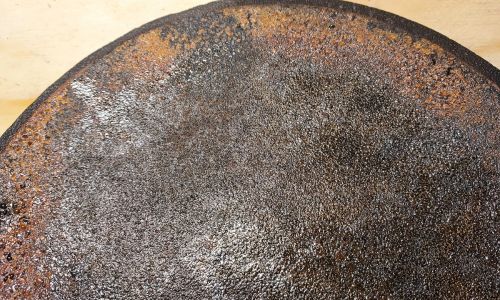
If you’ve got a new cast iron pan, you still want to give it a good washing in hot soapy water. This is to remove the protective layer of wax most cast-iron manufacturers apply to the surface.
Set your oven to at least 400 degrees. While it’s preheating wash your cast iron pan and wipe it dry.
You want to get the surface as dry as possible, without any traces of lint or old seasoning residue left on the surface.
Use a clean rag or paper towel to apply a thin layer of oil to every square inch of the cast iron surface.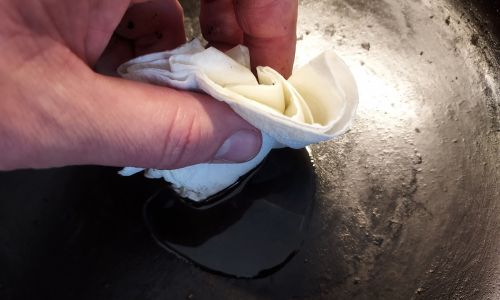
You want to use an oil with a high smoke point and neutral flavor that’s also polyunsaturated. These oils are more prone to polymerization than monounsaturated fats, which tend to burn.
When polyunsaturated fats are heated in dry conditions the process of polymerization creates a non-stick seasoning layer. This will both protect the cast iron cookware from rust while giving it some non-stick properties when you cook with it!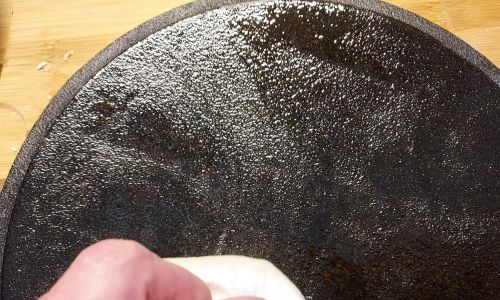
The best oils for seasoning cast iron cookware are canola, grapeseed, flaxseed, vegetable, coconut, vegetable shortening.
Place the cast iron cookware in an oven with the cooking surface facing down and allow it to bake for 20 to 30 minutes. This will let the oil polymerize into a rudimentary seasoning layer.
If you have an electric oven, you might want to put a disposable baking pan or a tinfoil-lined tray under the cast iron to catch any incidental drips.
After 20 to 30 minutes turn on the oven’s vent hood and remove the hot cast iron from the oven to apply another layer. Normal oven hot pads usually aren’t enough to let you handle the hot metal. You’ll want multiple hot pads or a robust welding glove when pulling the pan out of the oven.
You’ll really want that welding glove when wiping a thin layer of fresh oil on the surface of the pan.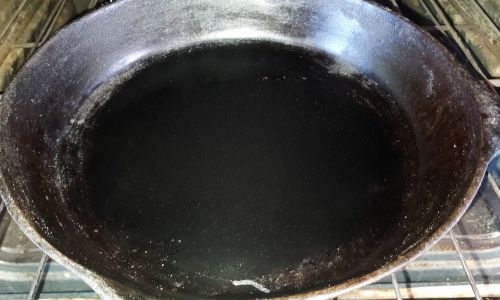
It’s normal for a little smoke to come off the cast iron surface as you’re wiping it down.
Then put the cast iron cookware back into the oven again to polymerize the second layer.
I like to repeat step four another two or three times for two hours. I keep pulling the cast iron out every 20 to 30 minutes and wiping on another layer of oil to keep building up the polymerized seasoning layers.
After 4 or 5 coats of oil like this, the cast iron surface should be fully protected, and ready to mature.
Seasoned cast iron cookware needs to be properly maintained and kept away from water in storage. The food you cook in it and just how much stuck-on mess clings to the cast iron surface will be a factor in how you clean it.
If you use your cast iron cookware to pan fry fish, make fried chicken, sauté vegetables, or even sear a steak with clarified butter, you can clean it with a meticulous wipe down.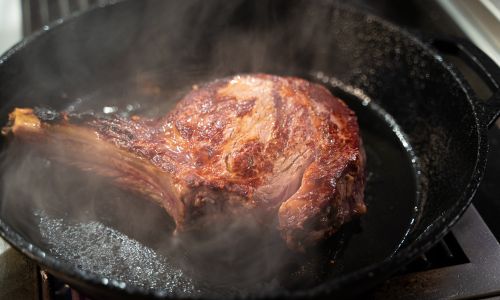
Step One: Pour out any excess oil.
Step Two: While it’s still hot, use a clean rag to wipe off the interior and exterior of the cast iron.
Step Three: Use a clean paper towel or three to wipe it completely clean.
Step Four: All it to cool completely, before putting it back in storage.
If you have a cast-iron Dutch oven or cast-iron pan that you use for making a soup, stew, or sloppy casserole, you might need to use a little water to clean it first.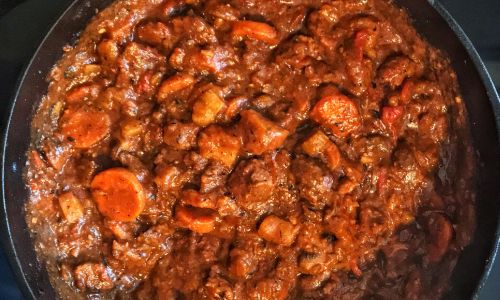
Step One: Remove all leftover soup, stew, or food from the cast iron cookware.
Step Two: Use steel wool to scour off any stuck-on food residue. Sometimes it’s so bad I need to use a clean putty knife and some elbow grease to completely clear away the ring of burned-on broth on the side of my cast iron Dutch oven.
Related: Dutch Oven – The Lost Art of Scratch Cooking
Step Three: If it needs it, you can lightly wash the cast iron cookware with a minimal amount of hot water. Then wipe it dry with a clean paper towel.
Step Four: Apply a protective layer of neutral-flavored polyunsaturated oil to all the areas that touched water to keep it from rusting in storage.
I’ve had times when a pan pizza or a campfire rigatoni went awry, leaving my cast iron pan so messed up that it truly needed to be soaked to get it clean.
Unfortunately, soaking for more than 5 minutes in warm soapy water usually strips or degrades the seasoning layer on the cast iron.
In a scenario like this, I will repeat the initial seasoning process all over again. Giving it three to four layers of polymerized oil protects it and restores its non-stick properties.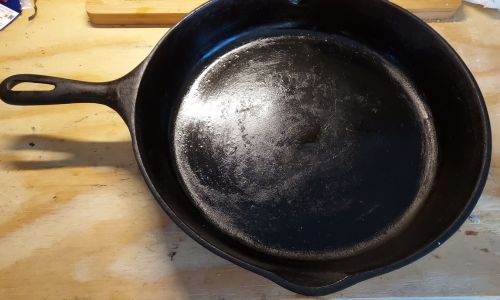
After reapplying a fresh seasoning layer to cast iron, I like to sauté some thick-sliced onions and peppers in a high-smoke point oil like vegetable or canola oil or clarified butter. I usually do it on the grill, while making fajitas over an open flame.
This imparts a little bit of onion flavor to the surface of the cast iron pan. You’ll appreciate this if you use the cast iron to make hamburger slides with the second cook!
A lot of people will tell you to use bacon, which I think is fine. The problem is the rendered fat that comes off bacon doesn’t polymerize very well, and there’s the risk of burning the lean meat in the bacon can damage an immature seasoning layer.
If you used a cast iron Dutch oven or skillet to make a stew and you’ve got a burned-on ring of sauce, you need to scrape it away completely. It’s a sign that water has infiltrated and degraded the protective seasoning layer.
At that point, I will rub the scraped surface down with a liberal amount of canola or vegetable oil. Then reheat the cast iron in the oven or over the campfire until I see a little smoke. At that point, I give the area another little wipe down with oil, and remove it from the heat, before letting it cool down for storage.
You may also like:
 The First Water Source That Will Disappear in a Crisis
The First Water Source That Will Disappear in a Crisis
Foods You Should Never Cook in Cast Iron (Video)
6 Signs Your Neighbor Will Become A Looter As Soon As SHTF
Ingenious Projects for Endless Hot Water Without Electricity
